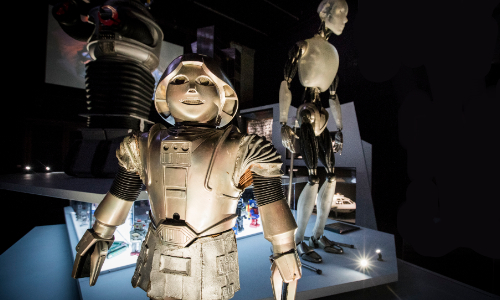Review: Into the Unknown

Into the Unknown: A Journey through Science Fiction is a brilliantly anarchic history of the genre, succeeding both as a surface-level crowd-pleaser and a rigorous collection that will give fresh perspective to even the most ardent of nerds.
The curation takes inspiration from the blockbuster exhibitions hosted by the V&A – from the moment you enter the Curve Gallery your senses are assaulted by competing video screens, with huge models dangling from the ceiling and brightly coloured prints covering every surface. The depth and breadth is astonishing, including rare first-editions, comics, trading cards, film props, video clips and original art.
To comprehensively cover a topic this broad is nigh-on impossible (scholars can’t even agree on what exactly sci-fi is), and curator Patrick Gyger tends to favour material from the mid-to-late 20th century, with an emphasis on movies and an overarching retro-futuristic aesthetic. He employs a “show don’t tell” approach: captions are brief and introductions snappy. It’s a collection rather than a thesis, happy to let the assorted memorabilia drag your attention through the gallery. You’re never given too much time to consider one item before something else steals your attention.
Displayed thematically rather than chronologically, it begins with early forays into sci-fi (the phrase was first coined in 1926, although many works here pre-date that ), with works by the likes of Jules Verne and Jonathan Swift. These older examples are full of giant crabs, tame dinosaurs and killer plants; new spins on things that would have been recognisable at the time. It’s a neat illustration of how sci-fi has always butted its head against the limits of human understanding.
It wasn’t until well into the 20th century that space travel became a mainstay. This is where the exhibition really excels, with dozens of models and costumes from films as diverse as Star Wars, Brazil and The Martian. A highlight is a room filled with space suits, including those worn by John Hurt in Alien, Leonard Nimoy in Star Trek and Cillian Murphy in Sunshine.
Later comes a section devoted to the utopia/dystopia dichotomy that lies at the heart of much science fiction, drawing on the “metabolism” trend of living in giant, interconnected megastructures. Here a high-point is a video installation by Pierre-Jean Giloux featuring a CGI city made up of rotating skyscrapers built into vertiginous double helixes. Other rooms focus on topics as diverse as fear of the apocalypse and the depiction of robots, the latter featuring life-size models of TARS from Interstellar and B-9 from cult TV show Lost in Space.
The exhibition isn’t limited to the Curve Gallery, either: screening rooms and video-game stations are dotted throughout the Barbican. In the basement a robot arm grumbles away to itself, spinning around in a disconcertingly human manner, a torch in its metal hand casting strange shadows across the perforated sheets that encircle it.
Even with the spill-over, the exhibition runs out of space, with big ideas like time-travel and the singularity limited to one or two pieces; a symptom of the size of its collection rather than the scope of its ambition. Into the Unknown is an unmissable snapshot of this vibrant genre, packed with items you may never get another chance to see.
First published in City A.M.

